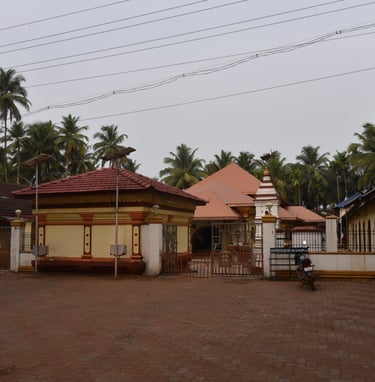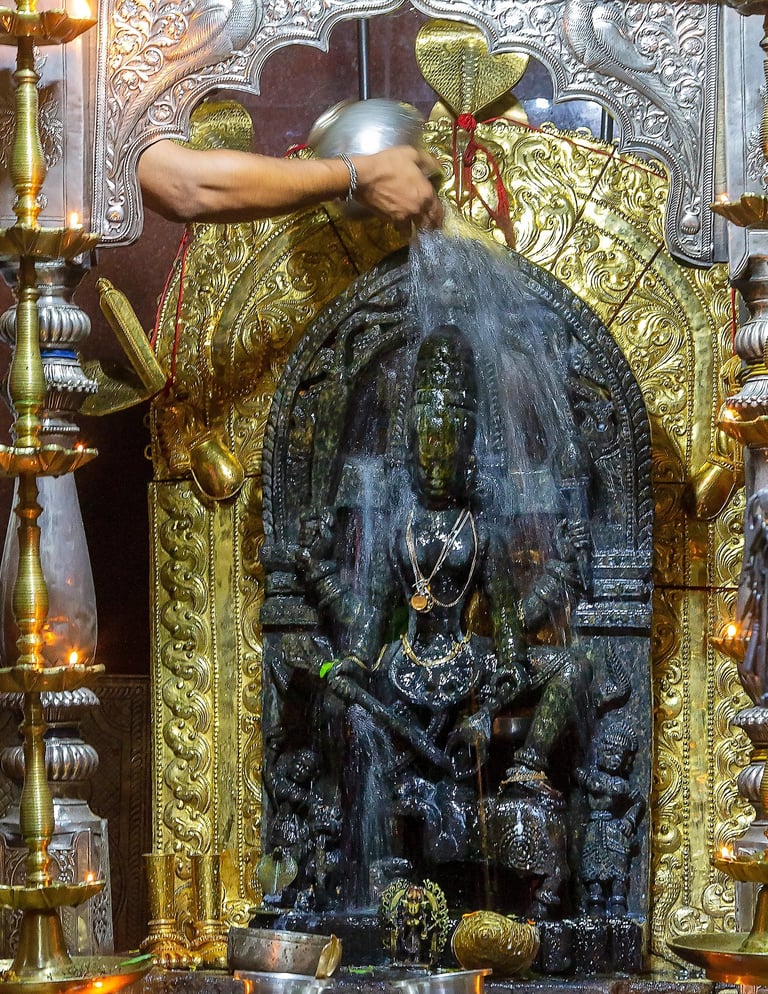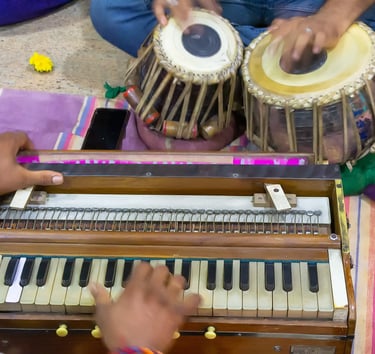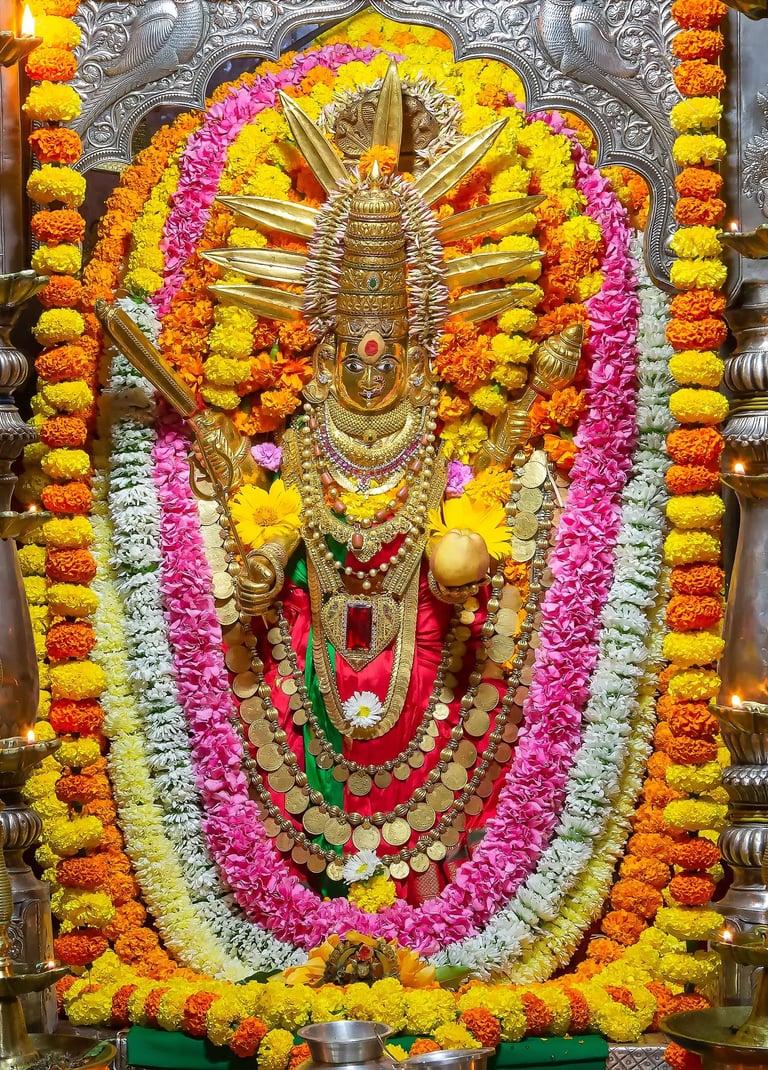

Profile
Shree Katyayani Baneshwar Temple is located in Aversa village, Ankola Taluka, Uttara Kannada District of Karnataka State. The temple is well connected by road, rail, water and air. It is just at 1 km distance from National Highway No. 17.
The taluka headquarters at Ankola is at 10 kms away and district head quarter in Karwar is at a distance of 25 kms from the temple. Nearest railway station is of Konkan Railway Corporation Limited at Harwada at distance of 2 kms. Main railway station at Karwar is at a distance of 28 kms. Nearest port is at Karwar. The Dabolim Airport of Goa at Vasco da Gama is the nearest airport to the temple at a distance of 120 kms. The airport at Mangalore is at a distance of about 250 kms from the temple.
The temple is managed by Shree Katyayani Baneshwar Temple Trust bearing registration No. A 350 (KWR). With generous support of devotees various facilities have been provided at the temple complex like Vasati Graha comprising 51 rooms, kalyan mantap, canteen etc.
An important feature of the temple complex is that the temple area is run on solar energy.
This website gives brief history of the temple, important utsavas, details of Shashwat Seva, Nitya Seva, format for sending kanika for One day Seva etc.


Concise History
A concise history regarding our ancestors the Saraswat Brahmins
As their population increased they were classified into five divisions based on their place of settlement.


The Skanda Puranas mention that Saraswat Brahmins habituated North vindyagiri (Kashmir). They resided on the banks of the Saraswati River. Historical records/ narration state that this clan comprised of well educated, highly intelligent people with exceptional cultural and social backgrounds. It is the popular belief that the Vedas and many other holy scriptures of the Hindus originated on the banks of this sacred river.
1. Saraswats – those who lived along the banks of Saraswati River.
2. Kanya Kubjas – those who lived along the river Kanoj.
3. Gouds – those who lived on the banks of the Southern Ganga
4. Utkalas – the people who lived in Orissa.
5. Mythilis – those who lived along the Mythila river in Bihar.
Severe drought and famine over a long spell of 12 years, struck the banks of the Saraswati River. Our ancestors, the Saraswats were forced to migrate towards Gomanthak, which is presented day Goa. The people of the South, known as Dravidas, addressed these Saraswats as Gouds or people coming from the Gouda providence of the northern part of the country. Thus this prefix Gouda Saraswat Brahmins which continues to this day.
Originally the Saraswats belonged to six holy lineages of Gothras, namely
1. Dattatreya,
2.Bharadwaja,
3. Pala Deva,
4. Apamanya,
5. Madagala,
6. Daumyayana.
References in records show that over a long period of time, these six lineages (gotras) were further dived into 199 lineages’s spread amongst Saraswats all over India. At present in South India, seven lineages (Gotras) namely 1. Jamadagni, 2. Bharadwaja, 3. Atri, 4. Kashyapa, 5. Koundinya, 6. Vaisa 7.Kaushik are in prevalence. Majority of them are worshippers of Shiva and Shakthi under various names.
History And Legend
Having arrived in Gomantaka, our ancestors chose Sashasti provinces (present Madgaon) for their settlement. They prospered and by nature being religious, turned their minds to their Kuladevatha. This resulted in building a beautiful temple at Banavli where they worshipped Shree Katyayani and Shree Baneshwar and accompanying deities (Parivar Devathe) with customary rituals and traditions, and all faith and devotion.
Eventually Gomantaka came under Portuguese invasion and Portuguese invasion and these foreigners resorted to forcibly converting people to Christianity. Unable to resist the Portuguese, our ancestors decided to migrate elsewhere.
Around the 15th/16th centuries the Kharvi people of Belekeri used to go to Goa in their boats for trade. The sad plight of the Saraswats under the Portuguese regime made them decide to give a helping hand. Some Kulavee Mahajans along with temple priests and the idols of Gods, their ornaments and other itinerary of the temple, were transported by boat to Belekeri near Aversa by the Kharvi tribe. With the consent of BHUDEVI (Grama Devatha) and on a plot given by her, our ancestors built a small temple at Aversa and started their daily rituals of worship to our Kuladevi Shree Katyayani.
To this day, there is a custom of serving the Prasada Bhojana to seven families of the Kharvi community in front of the Shrine (Gudi) of Shree Grama Purusha on the full moon day in the month of ASHVINA (Ashvin Shudda Poornima). This is as a token of gratitude to the Kharvi community for their timely help.
Further facts that reveal the construction of present temple
Once a rich merchant named Paulekar was transporting valuable merchandise in a big boat. Nearing Belekeri, his boat was caught in a squall (high winds and heavy rain) and craft ran aground on the shore. Inspite of his best efforts, he could not set his boat afloat. Being a Kulavee of Shree Katyayani and disheartened by his plight, he came to the temple at Aversa. The night was pitch dark, no one was around, as the Pujari had completed his pooja rituals and gone home. From a small opening in the temple door, the light of the lamps lit within could be seen. The fragrance of camphor and sandal filled the air. The serenity and peacefulness of the atmosphere helped in calming the worried merchant and in this mood he prostrated before the Kulaswamini, narrated his difficulties and vowed to construct a temple in the shape of a boat if SRI DEVI extricated him from his troubles. He then returned to his boat and slept well. Towards dawn he had a dream that an eight-year-old girl was pushing his boat with a large barge pole and setting it afloat. He awoke with a start and found it was not merely a dream but a reality. His boat was floating in the sea. As he contemplated, he was struck by the similarity between the face of the idol in the temple and the face of the little girl of his dreams. He was certain that our Kulaswamini had saved him from disaster. With joy in his heart and a deep sense of gratitude he went to the temple at Aversa, where a greater surprise awaited him. He saw we footprints marked with sand and was convinced beyond doubt that Shree Katyayani had saved his boat and merchandise. He stood before the Deity in all humility, offered pooja and vowed to build the temple as soon as possible and left the place.
Parulekar’s business transactions resulted in huge profits and all his time and energy went into the expanding of business and allied monetary gains. In the process he forgot his vow to the Goddess and the help rendered by Her. After a lapse of a few years, when his boat was passing near Balekeri, it suddenly came to a stop. This reminded him that he had not fulfilled his vow given to Sri Kuladevi. He hastened to Aversa and begged for forgiveness for his omissions. He then built the present temple which has a roof resembling an overturned boat.
A FEW SIGNIFICANT POINTS TO REMEMBER ARE
1. This is the only temple from Goa, to be relocated with all the original idols of the main deities of Shree Katyayani, Shree Baneshwar and various other accompanying deities of our Kuladevi.
2. According to the customs of this temple, Pooja’s are performed first to Shree Katyayani and then to Shree Baneshwar and then to Shree Ganapathi. This is the speciality of the pooja rituals here.
The other deities worshipped are Sri Grama Purusha, Sri Rama Purusha, Sri Nirakara, Sri Kalabhairava and Sri Dada. The idol of Sri Ganapathi is at the entrance of the shrine of Sri Baneshwar.
There is a legend narrated often about Shree Katyayani and Her Blessings towards her devotee’s sincerity and devotion. Once a devotee vowed that he would adorn the Goddess with a thousand rupees worth of Marigold (Gonde) flowers, if he succeeded in the venture he was about to undertake. Success was his and towards fulfilling his vow he came to Aversa. It was not the season for Marigold (Gonde) flowers and having come to the temple he realized that it was impossible to buy a thousand rupees worth of Marigold flowers in that small village and in that particular season. Looking around, he spotted a little girl with single Marigold (Gonde) flower in her basket. He offered to buy it and the little girl demanded Rs.1000/- for it. He had vowed to adorn the Kuladevi with Rs.1000/- worth of Marigold (Gonde) flowers and this one flower was costing him as much, so he decided that he would be fulfilling his vow by buying it. He paid the girl the amount and taking the flower, he entered the temple. Doubts filled his mind about offering that single flower to Devi. He came out and looked for the little girl but she was nowhere to be found. Finally he consoled himself that as promised he was offering Rs.1000/- worth of Marigold (Gonde) flowers even though it happened to be a single flower. In all humility and devotion he offered the single flower to Sri Devi. Then with worry and fear he waited in the temple for some sign that Devi was satisfied with his offering. He waited long and as no visible signs where there, he sadly decided to end his life. He raised tearful eyes to Kuladevi’s face amd was surprised to see HER neck bent forward, as though with the weight of the flowers on HER head. He realized that Kuladevi had indicated HER satisfaction and pleasure by the forward bending of HER head. He offered Pooja to HER and with happiness in his heart and peace in his mind, he let the place.
This incident pin points that Kuladevi does not put any importance to quantity of the offering but is truthfulness of purpose and constant faith (Bhakthi) in us that is dear to HER. A selfless devotion, a prayer in distress never goes unanswered by HER. May SHE be always pleased and thus shower HER blessings on all of us.
A recent incident of a devotee offering Tulabhara to our Kulaswamini is worthy of note. A devotee had come to Aversa to perform Tulabhara of is child. The balance scale was placed in front of the Deity. The child was seated on one pan/platform. The bags of sugar were placed on the other plan/ platform. The sugar was found to be insufficient and there was no sugar available nearby. The parents were worried and when asked the priests suggested that there was some shortcoming in the offering which displeased the Devi. They narrated to the priest how they had weighed the child at home and brought the exact weight of sugar. The priest then explained to them that, this was their mistake. The child should have been weighed only in front of Kuladevi and the approximate weight of the sugar brought. When faced by difficulties and calamities, we make promises to God, which when over we try to fulfill with the least expense on our part. Devi needs no commodity from us, nor does SHE want our commercial skills. SHE needs nothing from us but our sincere faith, steadfast reverence and selfless devotion.
An incident happened about 10 years ago. Around 2 O’clock in the night a cargo laden truck was plying on the highway near Aversa. A man on the way side with luggage bundled in gunny bags waved his hands to stop the truck. The driver obliged. The man put his luggage on the back of the truck and sat beside the driver. Strangely, while on the road, though there were no temples nearby, the driver felt that he was hearing the ringing of temple bells. The more he thought about it, the ringing seemed to grow louder. Suspecting the stranger seated beside him, he drove the vehicle straight to a Police Station and narrated the events to them. When the police examined the luggage of the man, they found temple bells and various other articles that he had stolen from Shree Katyayani temple at Aversa. Early next morning the police handed over the articles to the temple authorities.
From this incident it is obvious that ADI SHAKTI Shree Katyayani Devi, while protecting those who do good, also punishes people who go astray and commit misdeeds. It was through HER divine intervention that the stolen articles of the temple were restored within a few hours.
Another incident happened around the year 2000. It was 2 O’ clock in the afternoon. After attending the mid-day pooja, all devotees had left the temple premises. A lone woman stood in front of the temple enjoying the serene and peaceful surroundings. It was then that she saw a tall well built man in silken robes and a turban on his head coming from near the Shree Kalabhairava Shrine. He had a sword in his hand and as she watched he walked majestically straight into the shrine of SRI GRAMA PURUSHA. Filed with curiosity, she went up to the Shrine of SRI GRAMA PURUSHA and found it locked. She wondered as to the identity of the man she had seen and also the significance of the event witnessed. In the evening she narrated her experience to the people at the temple, she was told that she had been lucky to have seen the human form of SRI GRAMA PURUSHA. Later she consulted an oracle in Dakshina Kannada and it was confirmed that she had indeed seen SRI GRAMA PURUSHA in person. She felt fully blessed. It is since believed that our Kulaswamini Shree Katyayani and the other divinities of the temple have sanctified the place with their divine presence (Sukshma Swarupa).
Once a Kulavee with his family – (wife and two children) travelled from Mumbai to Aversa. In those by-gone days, most of the rivers along the coast had no bridges, the roads were rough, the journey very cumbersome and tiring. Many hardships had to be endured if one had to pay a visit to the family Deity. This man and his family braved the journey and reached the highway near Aversa in the darkness of night. They did not know the way to the temple, and with wife, children and luggage, the man had no idea as to what could be done. All of a sudden, he saw a light (of a lantern) coming in his direction and as the light neared them, they could see an old man holding the lantern. He came up to them and enquired if they desired to visit Shree Katyayani temple and offered to guide them. He even offered to carry some of their heavy luggage. The road to the temple was not discernable without light. The man with family and rest of the luggage happily followed the old man to a thatched house near the temple. They set their luggage down in the house and turned to thank and reward the old man for his help but he was not to be found. Then they realized that it was none other than SRI KALABHAIRAVA, the protector of the sacred premises of SRI KULADEVI and the one chosen by HER to carry out HER wishes and commands. The man and his family felt disappointed at not having recognized SRI KALABHAIRAVA when he had appeared before them, but they were also thrilled that the Divine Mother had felt and shown such concern for their safety and sent HER messenger to guide them. Shree Katyayani bestowes loving care and concern for safety of HER Kulavees and Devotees akin to a mothers care of HER children (only much more so).
Since Sri Kalabhairava is the chosen one to carry out our Kulaswamini’s wishes it is widely believed that the old man who guided the family to safety must have been Sri Kalabhairava himself. Shree Katyayani attaches great value and importance to the reverence and devotion shown by the Kulavees and SHE guards them from misfortune and calamity.
It has always been the practice to prepare ‘NAIVEDYA’ (food offerings) to the Deity at the residence of the Priest. Some people raised objections and insisted that NAIVEDYA be prepared within the temple premises. Sri Devi was consulted regarding this through “MALI PRASADA”, SHE indicated that SHE was pleased with the NAIVEDYA prepared at the Priests’s house. No objections have been raised thereafter and the custom of preparing NAIVEDYA at the Archaka’s house still continues.
There are several incidents where some miscreants with wicked intentions and who could not bear to acknowledge our Devi’s “Karanika Shakthi” attempted to malign HER, but failed miserably. Dispite all this, Devi has shown tolerance and even today SHE is protecting us. IT is our good fortune that SHE is forever responding to our call and giving succor to us. We offer to ADI SHAKTI SHREE KATYAYANI our boundless and wholehearted obeisance.
Every human being has to reap the fruits of his/her past Karma whether good or bad in nature. Hence life is full of joys and sorrows, difficulties and woes. There are difficulties, hindrances, obstructions which may cause us despair and upset our peace of mind. But if we focus our faith on our Family Deity, worship HER with devotion and reverence and surrender ourselves in prostration to HER. Sri Mata will always protect us and enable us to overcome our predicament.
Pray to our Kulaswami Shree Katyayani, have full faith and trust in HER divine powers and always chant HER name (i.e. Namasmarane). Try to visit HER shrine as often as possible, otherwise, atleast once a year, and offer seva and pooja to HER and then your life will be full of bliss and happiness.
Our ancestors had followed this traditional path and taught us to do the same. If we follow their example and follow the same path, remembering our family deity and visit HER shrine as often as we can, there is no doubt that our life will be sanctified by being in HER very presence (that is by HER Darshan).
LET OUR KULASWAMINI, SHREE KATYAYANI & SHREE BANESHWAR SHOWER THEIR BLESSINGS ON ONE AND ALL.
Avatar Or Incarnation
Avatar or Incarnation of Devi Shree Katyayani
Noting from prevalent records (Shri Durga Sapthashathi) our ancestors narrate the details of Avatar of Shree Katyayani thus:-
The demon King Mahishasura after intense penance (Tapas) of years received indomitable powers from Lord Shiva. Power intoxicated him and with great arrogance he started distrurbing the Rishis in their holy rituals and attacking the Gods. His impudence led him to defeat INDRA and conquer his capital Amaravathi. Fearing his might and insolence, the Rishis and Gods approached Brahmma, Rudra and Lord Narayana and narrated their predicament. As Lord Maha Vishnu heard the details of Mahishasura’s misdeeds his clam face turned fierce and an intense cosmic ray of light (Divya Jyothi) emanated from his face. Similar cosmic rays of light emanated from the faces of Brahmma and Rudra. These rays of celestial/ cosmic lights merged and in its brilliance the divine form of Shree Devi Goddess was seen.
The Gods each then in turn offered a part of THEIR might (Shakthi) to HER. Rudra gave his Trishula, Vishnu his Chakra, Varuna his Conch and Vayu his Bow and Arrow. Agni gave his Shastayudha, Yama the Kaladanda, Indra his Vajrayudha & Airavatha, Jaldipathi hands his pasha, Brahmma the lotus flower, Ksheerasagara gives a white garland, white dress, Chudamani, ear rings, the crescent moon necklace and anklets. The sea God offers a garland of lotus flowers and the Himalayas transform into a lion (Vahana) to SRI DEVI.
This phenomenon was witnessed by a sage called Katyayana. He was a worshipper of SRI DEVI and cherished the desire of her being born as his daughter. Witnessing the incarnation made him change his desire of having HER as his daughter. His devotion intensified and he became one with HER. The Puranas reveal that the divine Goddess highly pleased with this devotion named herself after him as Katyayani.
Our Kulaswamini Shree Katyayani’s various names are Lokajanani, Shree Bhoodurga, Shree Durga, Mahamaye etc. Our ancestors worshipped this powerful Devi and considered her as their Kuladevi (Family Deity).

